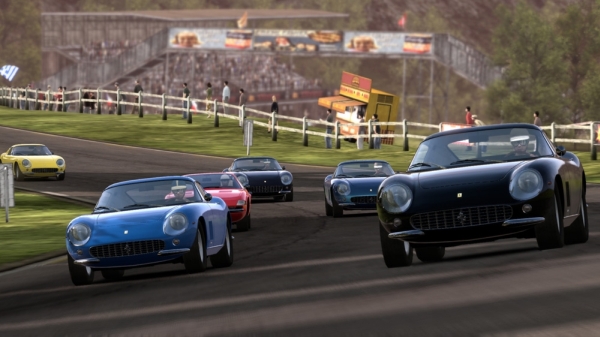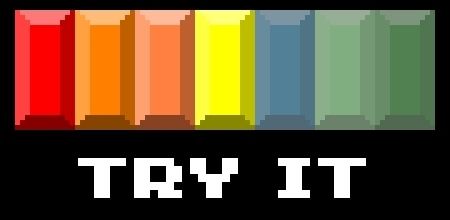
The last time we saw Atari’s Test Drive franchise, it was racing through the streets of Ibiza in Test Drive Unlimited 2. Since then, TDU developer Eden Games has run into some troubles, and the franchise as a whole seemed to be on the ropes. However, 2012 has brought us a very different use of the brand, with Test Drive: Ferrari Racing Legends. Developed by Slightly Mad Studios – the brains behind the short-lived Need For Speed: Shift franchise – this installment drops the open-world motif for a more traditional and narrowly focused racing experience, showcasing the lengthy history of one of the most exotic automobile manufacturers in the world.
Platforms: PC, PS3, Xbox 360 (Version Played)
Publisher: Atari
Developer: Slightly Mad Studios
Genre: Half Racing Game, Half History Lesson
Release: July 3, 2012
ESRB Rating: Everyone
Test Drive: Ferrari Racing Legends features a very robust career mode as its central source of action. Split into three eras, this career mode puts you behind the wheel of the earliest models, all the way up to the modern Ferrari vehicles. Each “age” of the campaign combines to deliver around 200 events, featuring basic races, hot laps, eliminators, one-on-one duels, and various unique events, such as racing against amateur movie stars, or… demonstrating the performance of a certain Ferrari model, that was on a certain 80’s television show, in a certain island state, starring a guy with a certainly awesome mustache. There’s definitely a lot of variety, and you’ll get to use numerous Ferrari models and plenty of real-world race tracks, which ultimately unlock for the other modes of play, be it exhibition races, time trials, or online play.
If you played either of the NFS Shift games, you’ll be surprised at how similar this plays. Perhaps it’s not a shock since it’s the same developer, but it’s pretty clear that Ferrari Racing Legends is based heavily on that engine. As such, you’re going to get a game that’s foundation is built upon the racing sim genre, but has moments of accessibility at the same time. In general, the cars handle very well, and even the looser ones can usually be grasped with some patience, but many of the quirks from the Shift games remain. Whether it’s the overall “heaviness” of the vehicles, or the terrible collision physics that enable a minor bump to turn into an insane crash that effectively forces a player to restart the race immediately, there are some real moments of frustration. At the same time, you get an awesome sense of speed, and when you find a car that handles to your liking, it’s a thing of beauty. Thankfully there’s three different handling models for various skill levels to ease the potential pain that the game could cause.
The career mode is definitely huge and will take at least 15 hours to get through, but it too has its problems. While splitting the game into three distinct eras is nice – and it’s even nicer that you can hop between these eras as you see fit – the progression is very linear. Rather than having access to numerous events at a time, you have to go down the list, one by one. While this is not a new thing by any means, it does cause some irritation if you get stuck on an event and have no real way to progress. Unfortunately, this happens surprisingly often, due to the bizarre difficulty spikes thrown at you. In general, TD: FRL is not a difficult game, and there’s an easy difficulty level for those truly stuck, but occasionally you’ll get an event that has a frustrating requirement or just plain superhuman AI tendencies. For instance, the race against amateur movie stars requires you to “sandbag” and let the stars have their fun. The objectives ask you to move up one position each lap, but no more or less. This would be fine, except sometimes a few cars will collide and spin out, forcing you to wait for everyone to get going in order to hold your position. As such, the pack that was not involved will be seconds ahead, enough to make it nigh impossible to catch up. Hence, you shall be acquainted with the restart option quite often. The AI can be rather troubling as well, due to their robotic patterns that could not care less if you’re in their spot… they’ll just block and push you around like you don’t exist.

If you do run into trouble with an event, there’s no way around it – you must finish it to move on. The understandable reason for this is due to the little storyline that plays out over all three eras, with each race telling more and more of the tale. It’s the usual macho racing story with all the typical tricks and tropes, but thankfully it’s relegated to loading screens and a blip next to the race description and can generally be ignored. Regardless, being unable to skip around and tackle races at your own pace seems really restrictive in 2012. Hopping between eras can help, but you’re going to encounter the same progression system no matter what. If it wasn’t for the weird times when a race suddenly gets overwhelmingly hard and/or stupid, it wouldn’t be an issue, but alas.
It doesn’t help that sometimes the career can just get… boring. If you’re like me and don’t hop between the eras, and instead complete each one fully before progressing, the grind can be tough. The entire “Golden” era features four tracks that you’ll have to compete on over and over. It’s not until you get into the “Modern” era that most of the courses make an appearance, reducing the monotony of racing Monza or Silverstone over and over. To the developer’s credit, they built the tracks to how they appeared during the era you’re racing in, so as you move up in time, they get more complex and interesting. Despite the track variety that eventually appears, the game frequently remains dull. This is because even on “normal” difficulty, most races are a cakewalk. Frequently I’ve found myself winning by an excess of 10 seconds or more. If it wasn’t for those crazy spikes in challenge, the game would be such a pushover.
TD: Ferrari Racing Legends is interesting visually because while it looks nice, it’s also very bland. There’s nothing “wrong” with how it looks, it just doesn’t have a lot of life, and sometimes it feels like you’re racing inside a static image. On the other hand, the frame rate is smooth despite the great sense of speed that usually means you’re too busy racing to notice the dull visual presentation. The cars themselves do look very nice; it’s obvious a lot of care was put into making them look as realistic as possible. Equally nice is the classy, yet mostly subtle HUD that gives you the basics but not much else. Considering the really neat HUD that Slightly Mad put into the Shift games, it’s no surprise they did another fine job. On the audio end of the presentation, there’s not much other than standard racing game sound effects, many of which were recycled from, well, I think you know where. You get some minor radio chatter from the typical disembodied racing game voice, and there’s a nice classical tune that plays in the menus, but otherwise… yeah. There’s just not much to discuss.
Most racing games based upon a single brand tend to be mailed-in budget games designed to attract a more casual audience – namely car aficionados who are loyal to a manufacturer. Hence, they’re usually not very good. Test Drive: Ferrari Racing Legends is not a bad game at all, as it’s obvious that all parties involved put plenty of care into developing it. The game is a great tribute to a legendary brand, and it comes off as both a history lesson and a racing simulation. At the same time, it’s not a great game either, as it tends to lack excitement on the track, and the structure of the career mode can be extremely monotonous, especially during the earlier eras. It has moments of brilliance, but it also has moments where you just want to put the game back on the shelf and do something else. All told, Ferrari Racing Legends is a decent enough game that’s usually pretty fun, but is decidedly second tier no matter what platform you’re playing it on. It’s the very definition of a “B” game, and there’s nothing wrong with that.

Review Disclosure: A review copy of Test Drive: Ferrari Racing Legends was provided by Atari for the purposes of this review.






